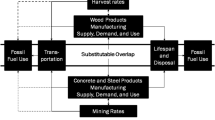Abstract
Using wood as a building material affects the carbon balance through several mechanisms. This paper describes a modelling approach that integrates a wood product substitution model, a global partial equilibrium model, a regional forest model and a stand-level model. Three different scenarios were compared with a business-as-usual scenario over a 23-year period (2008–2030). Two scenarios assumed an additional one million apartment flats per year will be built of wood instead of non-wood materials by 2030. These scenarios had little effect on markets and forest management and reduced annual carbon emissions by 0.2–0.5% of the total 1990 European GHG emissions. However, the scenarios are associated with high specific CO2 emission reductions per unit of wood used. The third scenario, an extreme assumption that all European countries will consume 1-m3 sawn wood per capita by 2030, had large effects on carbon emission, volumes and trade flows. The price changes of this scenario, however, also affected forest management in ways that greatly deviated from the partial equilibrium model projections. Our results suggest that increased wood construction will have a minor impact on forest management and forest carbon stocks. To analyse larger perturbations on the demand side, a market equilibrium model seems crucial. However, for that analytical system to work properly, the market and forest regional models must be better synchronized than here, in particular regarding assumptions on timber supply behaviour. Also, bioenergy as a commodity in market and forest models needs to be considered to study new market developments; those modules are currently missing.





Similar content being viewed by others
References
Backéus S, Wikström P, Lämås T (2005) A model for regional analysis of carbon sequestration and timber production. For Ecol Manag 216:28–40
Bengtson A (2003) Framing technological development in a concrete context: the use of wood in the Swedish construction industry. Ph.D. Dissertation, Department of Business Studies, Uppsala University, Sweden
Börjesson P, Gustavsson L (2000) Greenhouse gas balances in building construction: wood versus concrete from lifecycle and forest land-use perspectives. Energy Policy 28(9):575–588
Buchanan AH, Honey BG (1994) Energy and carbon dioxide implications of building construction. Energy Build 20(3):205–217
Buchanan AH, Levine SB (1999) Wood-based building materials and atmospheric carbon emissions. Environ Sci Policy 2(6):427–437
Cajander AK (1949) Forest types and their significance. Acta Forestalia Fennica 56:1–71
Eriksson E, Gillespie A, Gustavsson L, Langvall O, Olsson M, Sathre R, Stendahl J (2007a) Integrated carbon analysis of forest management practices and wood substitution. Can J For Res 37(3):671–681
Eriksson LO, Sallnäs O, Ståhl G (2007b) Forest certification and Swedish wood supply. For Policy Econ 9(5):452–463
Euroconstruct Conference (2006) The european housing market. Munich, 24 p
FAOSTAT (2008) FAOSTAT database. http://faostat.fao.org. FAO
Gustavsson L, Sathre R (2006) Variability in energy and carbon dioxide balances of wood and concrete building materials. Build Environ 41(7):940–951
Gustavsson L, Pingoud K, Sathre R (2006) Carbon dioxide balance of wood substitution: comparing concrete- and wood-framed buildings. Mitig Adapt Strateg Global Change 11:667–691
Gustavsson L, Holmberg J, Dornburg V, Sathre R, Eggers T, Mahapatra K, Marland G (2007) Using biomass for climate change mitigation and oil reduction. Energy Policy 35(11):5671–5691
HAF (Holzabsatzfonds) (2000) Holzkultur. (Wood culture), Timber sales promotion fund. Bonn, 39 p (in German)
Hänninen R (2008) Forecasts for coniferous sawnwood consumption in Europe 2003–2027. Manuscript for the project “Forest and wood-products to mitigate climate change”. Finnish Forest Research Institute, 16 p
Hoen HF, Solberg B (1994) Potential and economic efficiency of carbon sequestration in forest biomass through silvicultural management. For Sci 40(3):429–451
Hoen HF, Solberg B (1999) Policy options in carbon sequestration via sustainable forest management: an example from the North. In: Palo M (ed) Forest transition and carbon fluxes—global scenarios and policies. World Development Studies, vol 15. UNU/WIDER. Helsinki. pp 117–132
Hooke R, Jeeves TA (1961) “Direct search” solution of numerical and statistical problems. J Assoc Comput Mach 8:212–229
Johansson P-O, Löfgren K-G (1985) The economics of forestry and natural resources. Basil Blackwell, Oxford 292 p
Kallio AMI, Moiseyev A, Solberg B (2004) The global forest sector model EFI-GTM—the model structure. EFI Technical Report 15, 24 p
Kallio AMI, Moiseyev A, Solberg B (2006) Economic impacts of increased forest conservation in Europe: a forest sector model analysis. Environ Sci Policy 9:457–465
Koch P (1992) Wood versus nonwood materials in U.S. residential construction: some energy-related global implications. For Prod J 42(5):31–42
Lehtonen A, Mäkipää R, Heikkinen J, Sievänen R, Liski J (2004) Biomass expansion factors (BEFs) for Scots pine, Norway spruce and birch according to stand age for boreal forests. For Ecol Manag 188:211–224
Lippke B, Wilson J, Perez-Garcia J, Boyer J, Meil J (2004) CORRIM: life-cycle environmental performance of renewable building materials. For Prod J 54(6):8–19
Mahapatra K, Gustavsson L (2008) Multi-storey timber buildings: breaking industry path dependency. Build Res Inf 36(6):638–648
Moiseyev A, Solberg B, Michie B, Kallio AMI (2010) Modeling the impacts of policy measures to prevent import of illegal wood and wood products. For Policy Econ 10(1):24–30
Perez-Garcia J, Lippke B, Comnick J, Manriquez C (2005) An assessment of carbon pools, storage, and wood products market substitution using life-cycle analysis results. Wood Fiber Sci 37(Corrim Special Issue):140–148
Petersen AK, Solberg B (2002) Greenhouse gas emissions, life-cycle inventory and cost-efficiency of using laminated wood instead of steel construction. Case: beams at Gardermoen airport. Environ Sci Policy 5(2):169–182
Petersen AK, Solberg B (2003) Substitution between floor constructions in wood and natural stone: comparison of energy consumption, GHG emissions, and costs over the life cycle. Can J For Res 33(6):1061–1075
Petersen AK, Solberg B (2004) Comparison of GHG emissions and costs over the life cycle of flooring materials. Clim Change 64:143–167
Petersen AK, Solberg B (2005) Environmental and economic impacts of substitution between wood products and alternative materials: a review of micro-level analyses from Norway and Sweden. For Policy Econ 7(3):249–259
Pingoud K, Perälä A-L (2000) Arvioita puurakentamisen kasvihuonevaikutuksesta. 1. Skenaariotarkastelu potentiaalisesta puunkäytöstä ja sen kasvihuonevaikutuksesta vuosien 1990 ja 1994 uudisrakentamisessa. 2. Rakennuskannan puutuotteiden hiilivaranto Suomessa: inventaariot vuosilta 1980, 1990 ja 1995 [Studies on greenhouse impacts of wood construction. 1. Scenario analysis of potential wood utilisation in Finnish new construction in 1990 and 1994. 2. Inventory of carbon stock of wood products in the Finnish building stock in 1980, 1990 and 1995.] Publication 840, Technical Research Centre of Finland, VTT Julkaisuja, Espoo. (in Finnish, abstract in English). http://www.inf.vtt.fi/pdf/julkaisut/2000/J840.pdf
Pingoud K, Pohjola J, Valsta L (2010) Assessing the integrated climatic impacts of forestry and wood products. Silva Fennica 44(1):155–175. http://www.metla.fi/silvafennica/full/sf44/sf441155.pdf
Pohjola J, Valsta L (2007) Carbon credits and management of Scots pine and Norway spruce stands in Finland. For Econ Policy 9:789–798
Porter ME, van der Linde C (1995) Toward a new conception of the environment-competitiveness relationship. J Econ Perspect 9(4):97–118
Raymer AKP, Gobakken T, Solberg B, Hoen HK, Bergseng EF (2009) A forest optimisation model including carbon flows: application to a forest in Norway. For Ecol Manag 258(5):579–589
Reid H, Huq S, Inkinen A, MacGregor J, Macqueen D, Mayers J, Murray L, Tipper R (2004) Using wood products to mitigate climate change: a review of evidence and key issues for sustainable development. International Institute of Environment and Development. Jan, 90 p. http://www.iied.org/pubs/pdf/full/10001IIED.pdf
Sallnäs O (1990) A matrix growth model of the Swedish forest. Studia Forestalia Suecica. No. 183. SLU, Uppsala
Sallnäs O, Eriksson LO (1989) Management variation and price expectations in an intertemporal forest sector model. Nat Resour Model 3:385–398
Samuelson PA (1952) Spatial price equilibrium and linear programming. Am Econ Rev 42:283–303
Sathre R, Gustavsson L (2006) Energy and carbon balances of wood cascade chains. Resour Conserv Recycl 47(4):332–355
Sathre R, Gustavsson L (2007) Effects of energy and carbon taxes on building material competitiveness. Energy Build 39(4):488–494
Sathre R, Gustavsson L (2009) Using wood products to mitigate climate change: external costs and structural change. Appl Energy 86(2):251–257
Sathre R, O’Connor J (2010) Meta-analysis of greenhouse gas displacement factors of wood product substitution. Environ Sci Policy 13(2):104–114
Solberg B, Moiseyev A, Kallio AMI, Toppinen A (2010) Forest sector market impacts of changed roundwood export tariffs and investment climate in Russia. For Policy Econ 10(1):17–23
Taverna R, Hofer P, Werner F, Kaufmann E, Thürig E (2007) The CO2 effects of the Swiss forestry and timber industry. Scenarios of future potential for climate-change mitigation. Environmental Studies No. 0739. Federal Office for the Environment, Bern. 102 p
Toratti T (2001) A survey on the current situation and research needs of wood construction in Europe. Wood Construction Network Seminar, 7 Nov 2001, Lahti, Finland. http://www.vtt.fi/rte/bss/cooperation/paneuro/toratti_survey_paper.pdf
Valsta L (1992) An optimization model for Norway spruce management based on single-tree growth models. Acta Forestalia Fennica 232:1–20
Valsta L (2007) Sequester or harvest—the optimal use of managed forests to mitigate climate change. University of Helsinki, Department of Forest Economics, Reports 46, 23 p
van de Kuilen J-WG (2001) Research of wood as a construction material and current situation of wood construction in the Netherlands. Wood Construction Network Seminar, 7 Nov 2001, Lahti, Finland
Acknowledgments
The research for this article has been partly financed by SNS, SamNordisk Skogsforskning.
Author information
Authors and Affiliations
Corresponding author
Additional information
Communicated by K. Rosen.
This article originates from the context of the EFORWOOD final conference, 23–24 September 2009, Uppsala, Sweden. EFORWOOD—Sustainability Impact Assessment of Forestry-wood Chains. The project was supported by the European Commission.
Rights and permissions
About this article
Cite this article
Eriksson, L.O., Gustavsson, L., Hänninen, R. et al. Climate change mitigation through increased wood use in the European construction sector—towards an integrated modelling framework. Eur J Forest Res 131, 131–144 (2012). https://doi.org/10.1007/s10342-010-0463-3
Received:
Revised:
Accepted:
Published:
Issue Date:
DOI: https://doi.org/10.1007/s10342-010-0463-3




